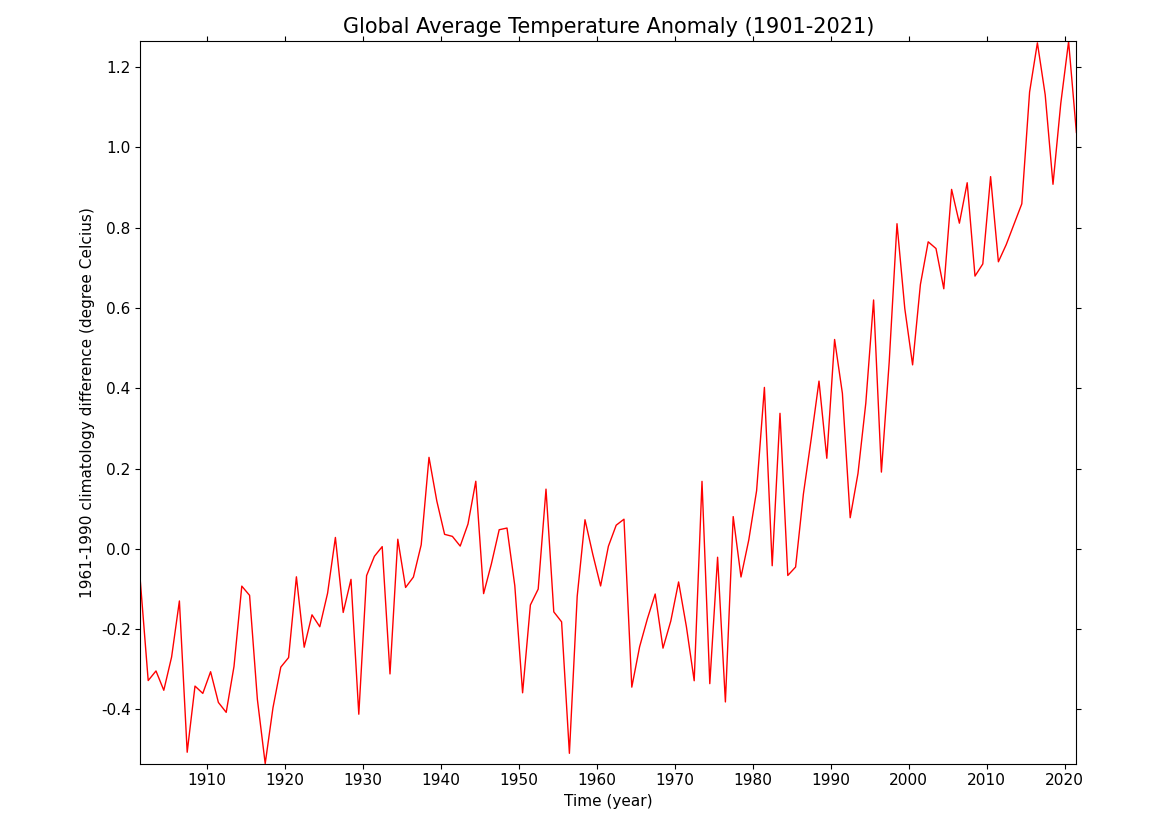Note
Click here to download the full example code
Calculating and plotting the global average temperature anomalies¶
In this recipe we will calculate and plot the global average temperature anomalies.
Import cf-python and cf-plot:
import cfplot as cfp
import cf
Read the field constructs:
[<CF Field: ncvar%stn(long_name=time(1452), long_name=latitude(360), long_name=longitude(720))>,
<CF Field: long_name=near-surface temperature(long_name=time(1452), long_name=latitude(360), long_name=longitude(720)) degrees Celsius>]
Select near surface temperature by index and look at its contents:
Field: long_name=near-surface temperature (ncvar%tmp)
-----------------------------------------------------
Data : long_name=near-surface temperature(long_name=time(1452), long_name=latitude(360), long_name=longitude(720)) degrees Celsius
Dimension coords: long_name=time(1452) = [1901-01-16 00:00:00, ..., 2021-12-16 00:00:00] gregorian
: long_name=latitude(360) = [-89.75, ..., 89.75] degrees_north
: long_name=longitude(720) = [-179.75, ..., 179.75] degrees_east
Select latitude and longitude dimensions by identities, with two different techniques:
lon = temp.coordinate("long_name=longitude")
lat = temp.coordinate("Y")
Print the description of near surface temperature to show properties of all constructs:
-----------------------------------------------------
Field: long_name=near-surface temperature (ncvar%tmp)
-----------------------------------------------------
Conventions = 'CF-1.4'
_FillValue = 9.96921e+36
comment = 'Access to these data is available to any registered CEDA user.'
contact = 'support@ceda.ac.uk'
correlation_decay_distance = 1200.0
history = 'Fri 29 Apr 14:35:01 BST 2022 : User f098 : Program makegridsauto.for
called by update.for'
institution = 'Data held at British Atmospheric Data Centre, RAL, UK.'
long_name = 'near-surface temperature'
missing_value = 9.96921e+36
references = 'Information on the data is available at
http://badc.nerc.ac.uk/data/cru/'
source = 'Run ID = 2204291347. Data generated from:tmp.2204291209.dtb'
title = 'CRU TS4.06 Mean Temperature'
units = 'degrees Celsius'
Data(long_name=time(1452), long_name=latitude(360), long_name=longitude(720)) = [[[--, ..., --]]] degrees Celsius
Domain Axis: long_name=latitude(360)
Domain Axis: long_name=longitude(720)
Domain Axis: long_name=time(1452)
Dimension coordinate: long_name=time
calendar = 'gregorian'
long_name = 'time'
units = 'days since 1900-1-1'
Data(long_name=time(1452)) = [1901-01-16 00:00:00, ..., 2021-12-16 00:00:00] gregorian
Dimension coordinate: long_name=latitude
long_name = 'latitude'
units = 'degrees_north'
Data(long_name=latitude(360)) = [-89.75, ..., 89.75] degrees_north
Dimension coordinate: long_name=longitude
long_name = 'longitude'
units = 'degrees_east'
Data(long_name=longitude(720)) = [-179.75, ..., 179.75] degrees_east
Latitude and longitude dimension coordinate cell bounds are absent, which are created and set:
a = lat.create_bounds()
lat.set_bounds(a)
lat.dump()
Dimension coordinate: long_name=latitude
long_name = 'latitude'
units = 'degrees_north'
Data(360) = [-89.75, ..., 89.75] degrees_north
Bounds:units = 'degrees_north'
Bounds:Data(360, 2) = [[-90.0, ..., 90.0]] degrees_north
b = lon.create_bounds()
lon.set_bounds(b)
lon.dump()
Dimension coordinate: long_name=longitude
long_name = 'longitude'
units = 'degrees_east'
Data(720) = [-179.75, ..., 179.75] degrees_east
Bounds:units = 'degrees_east'
Bounds:Data(720, 2) = [[-180.0, ..., 180.0]] degrees_east
print(b.array)
[[-180. -179.5]
[-179.5 -179. ]
[-179. -178.5]
...
[ 178.5 179. ]
[ 179. 179.5]
[ 179.5 180. ]]
Time dimension coordinate cell bounds are similarly created and set for cell sizes of one calendar month:
time = temp.coordinate("long_name=time")
c = time.create_bounds(cellsize=cf.M())
time.set_bounds(c)
time.dump()
Dimension coordinate: long_name=time
calendar = 'gregorian'
long_name = 'time'
units = 'days since 1900-1-1'
Data(1452) = [1901-01-16 00:00:00, ..., 2021-12-16 00:00:00] gregorian
Bounds:calendar = 'gregorian'
Bounds:units = 'days since 1900-1-1'
Bounds:Data(1452, 2) = [[1901-01-01 00:00:00, ..., 2022-01-01 00:00:00]] gregorian
Calculate the area weighted mean surface temperature for each time using the collapse method:
global_avg = temp.collapse("area: mean", weights=True)
Calculate the annual global mean surface temperature:
annual_global_avg = global_avg.collapse("T: mean", group=cf.Y())
The temperature values are averaged for the climatological period of 1961-1990 by defining a subspace within these years using cf.wi query instance over subspace and doing a statistical collapse with the collapse method:
annual_global_avg_61_90 = annual_global_avg.subspace(
T=cf.year(cf.wi(1961, 1990))
)
print(annual_global_avg_61_90)
Field: long_name=near-surface temperature (ncvar%tmp)
-----------------------------------------------------
Data : long_name=near-surface temperature(long_name=time(30), long_name=latitude(1), long_name=longitude(1)) degrees Celsius
Cell methods : area: mean long_name=time(30): mean
Dimension coords: long_name=time(30) = [1961-07-02 12:00:00, ..., 1990-07-02 12:00:00] gregorian
: long_name=latitude(1) = [0.0] degrees_north
: long_name=longitude(1) = [0.0] degrees_east
temp_clim = annual_global_avg_61_90.collapse("T: mean")
print(temp_clim)
Field: long_name=near-surface temperature (ncvar%tmp)
-----------------------------------------------------
Data : long_name=near-surface temperature(long_name=time(1), long_name=latitude(1), long_name=longitude(1)) degrees Celsius
Cell methods : area: mean long_name=time(1): mean
Dimension coords: long_name=time(1) = [1976-01-01 12:00:00] gregorian
: long_name=latitude(1) = [0.0] degrees_north
: long_name=longitude(1) = [0.0] degrees_east
The temperature anomaly is then calculated by subtracting these climatological temperature values from the annual global average temperatures and plotted:
temp_anomaly = annual_global_avg - temp_clim
cfp.lineplot(
temp_anomaly,
color="red",
title="Global Average Temperature Anomaly (1901-2021)",
ylabel="1961-1990 climatology difference ",
yunits="degree Celcius",
)

Total running time of the script: ( 0 minutes 57.423 seconds)